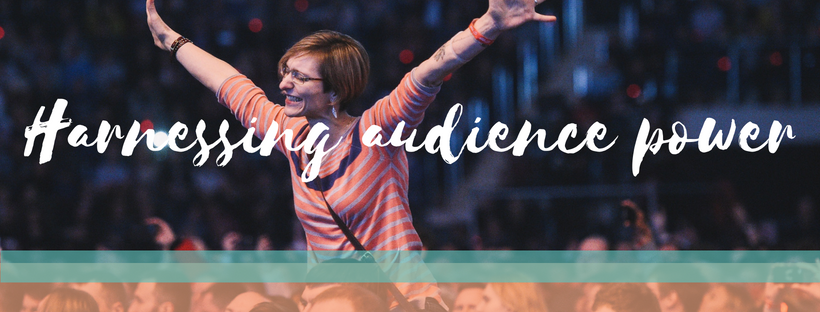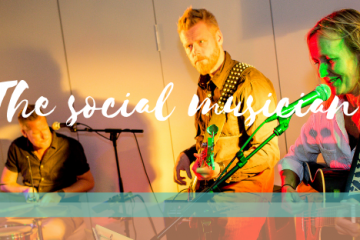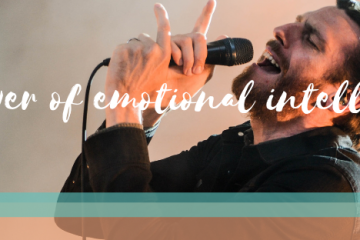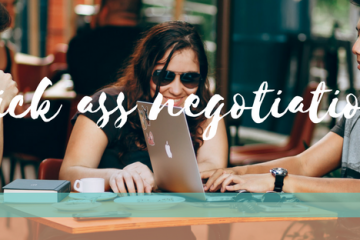
Live music performance is about unity. Connection. Love. Belonging. Healing. Escape. It’s about feeling and experiencing. There are few times in life that we really feel as free and connected as we do at a live music concert, perhaps that’s why us humans enjoy them so much.
What power does your audience have?
Live shows are unpredictable, exhilarating and often have an incredible energy that stays with you afterwards. You, as the musicians, create that vibe with your talent and the music you play. But it’s not only you. There’s something else playing a huge part in the experience and energy of your show… The crowd.
I recently visited the Cheltenham Jazz Festival and was watching a jazz pianist play on a very small stage. At the end of the set, he started singing ‘yellow’ by Coldplay and the crowd joined in. Every single member of the crowd. I could feel goose bumps rising up my arms… My eyes were welling up with tears… I was experiencing musical frisson from this beautiful moment and it wasn’t the musician that caused it. It was the audience of 200 people singing in unison.
I’m sure we’d all agree that if the Rolling Stones were performing in your living room just for you then it’d be amazing… But it would be a completely different experience to watching them with 100,000 other people in a stadium, singing and connecting, together.
If you harness the power of your audience well, you can boost the experience of every single person at your show. That’s how you turn an ordinary show into a memorable experience that your fans will never forget.
How can you harness the power of your audience?
Let’s explore some stunning recent examples of audience participation, to see what lessons we can learn from the masters. *If you’d just like to get straight to the top tips, then scroll down to the bottom of the page*
KASABIAN – L.S.F. (Lost Souls Forever) – live @ The O2 Arena, London
3 minutes onwards (be warned, the language is colourful)
Kasabian finished each show from their 2017 tour with the same challenge for their fans. This challenge was for the fans to break the decibel level for the tour, just by singing. They displayed a decibel counter on the big screens and fans could watch the level rise as they sang louder and louder. Watch this video to see what happened in London.
See how much louder the crowd become after Serge announces that the number on the big screens is a DB level? Then how much more sound they manage to produce when he says “sing as loud as you f&*£$%g can”? Incredible!
So what can we learn from this?
- Serge doesn’t ask. He tells. There’s no room for your crowd to opt out, there’s no decision to be made… You’re part of the team
- The instruction is concise and the task is easy
- He addresses specific individuals and encourages them (“yes sister!” “yes brother” “this is powerful” “great bum bag” “I love ya”) This makes people feel good about their participation, safe, valued, and part of the movement
- It’s a game, and it’s visual. They can see, hear and feel the impact of their singing – what’s more motivating than that?!
Fan sings the Beyoncé song in concert and she rocks!
1 minute 2 seconds onwards
At this huge show, Beyoncé walks over to the crowd as she often does… This time she’s singing Halo, and decides to hand the microphone to an audience member for her to continue singing the song. Watch the video to see what happens.
So what can we learn from this?
- She walks to the audience, rather than staying on stage (which is separating her from an intimate connection with the crowd). This encourages interaction and connection
- Beyoncé uses her body language so well. Clapping and smiling encourages the audience member to continue singing
- “Thank you so much” She thanks the audience member for singing to her. A beautifully humble act, that shows her appreciation for a stunning and unexpected moment of connection and talent
Robbie Williams – Angels (Live at Knebworth)
2 minutes 16 seconds onwards
Robbie Williams finally decided to hand over his song ‘Angels’ to the audience after over 2 minutes of them passionately singing every single word with him. There are multiple videos of audiences singing with Robbie, and almost every time you can see the palpable emotion on his face… I can’t even imagine what it feels like to have 375,000 people sing your song back to you; that must be a feeling hard to beat.
So what can we learn from this?
- We need to write hit songs! Arguably Robbie hasn’t done much on stage here, apart from be the person on stage performing an incredible song, which is loved the world over. But he has done a few things to encourage the singing…
- Robbie comes across as very humble because he’s not afraid to show emotion on stage. This has an interesting effect on audiences… It becomes almost a gift that they’re giving him, which feels great
- You can only battle against it for so long. Robbie stepped back and allowed the audience to continue… He didn’t fight against it… He allowed each audience member to seize the moment, sing, and connect with the 374,999 other people there doing the same thing
Here’s another beautiful example of the crowd taking over a song from the artist. This time, the song is being performed by Adele at the Royal Albert Hall in London.
Craziest crowd control ever!! (Part 1)
22 seconds onwards and 1 minute 10 seconds (be prepared for explicit language)
This video filmed at the music festival, Defqon. 1, is absolutely incredible. A crowd of 50,000 people singing and dancing in time together… All moving as one, after being instructed by the MCs.
So what can we learn from this?
- Very clear, simple instructions work best to engage your audience
- Unite the crowd with a common, fun goal and they’ll make it happen
- Like Kasabian, they do not ask whether the crowd would like to get involved. They tell them what to do. There’s no option to decide against participating, you’ll be left behind (physically in this case!)
- The crowd is in control of what’s happening, and it looks like a lot of fun to miss out on… Maybe that’s part of the motivation to join in
Bobby McFerrin Demonstrates the power of the pentatonic scale
17 seconds onwards
The cleverest example of crowd interaction I’ve ever seen. Bobby McFerrin uses crowd participation to demonstrate the power of the pentatonic scale. He managed, to a certain extent, to demonstrate not only the power of a unified crowd, but also the human brain to adapt and predict musical notes. Take notes!
So what can we learn from this?
- Bobby shows the audience how it’s done, before moving on
- The instructions are very clear and the actions are simple
- Sometimes the most creative ideas are the most powerful and memorable
Takeaway learning:
- Simple and easy tasks are most effective to get your fans involved
- Give your fans concise instructions. Don’t ask, tell
- Embrace the audience and make them feel good about participating… Part of the tribe
- Be humble, smile, and make authentic connections
- Make it fun for you and them
- Get creative and prepare audience participation in advance
- Don’t battle the crowd. If they want to sing your song at the top of their lungs then step aside and let them. Enjoy the moment
Remember that your fans are there for you – they are at your show to connect with you and each other. If you can facilitate an even greater experience of connection and fun for them, you’ll create the type of experience that’ll be hard to forget… For all the best reasons.
Over to you… What are your top tips for harnessing the power of an audience? We’d love to hear your thoughts. We’d also like to see more examples of great crowd participation… Have you come across any other powerful examples?
If you’ve enjoyed this article, then please share it using our social media icons below.


